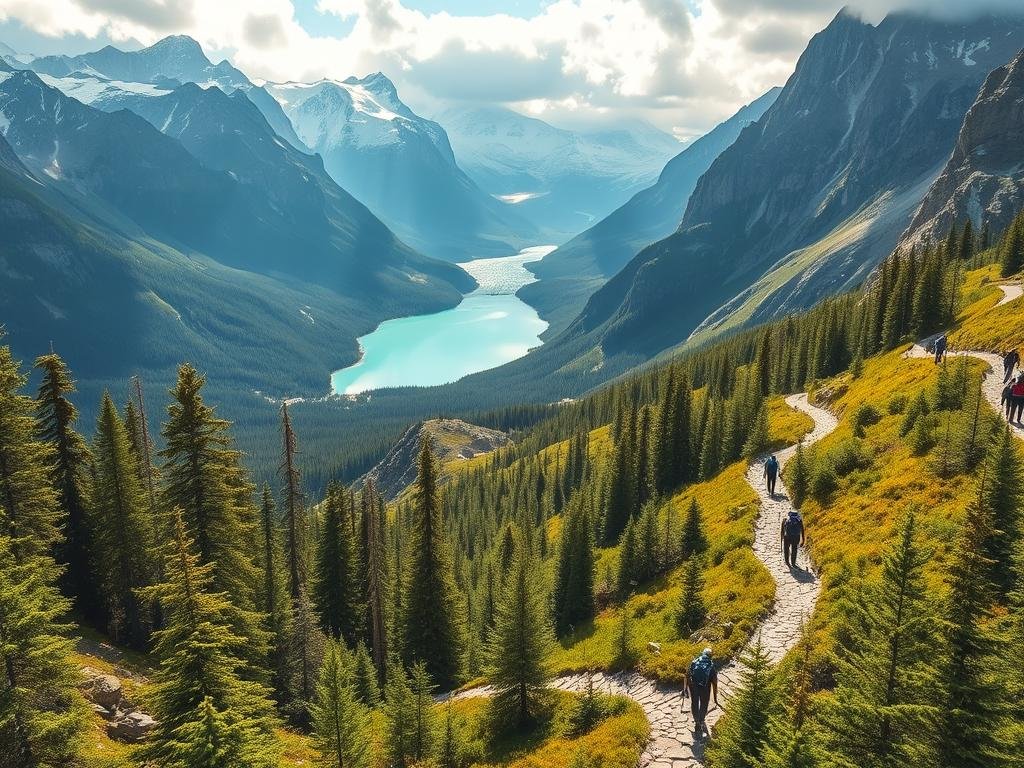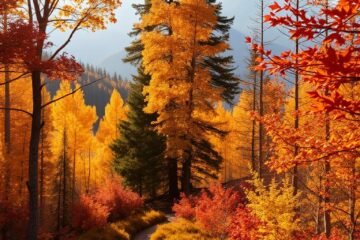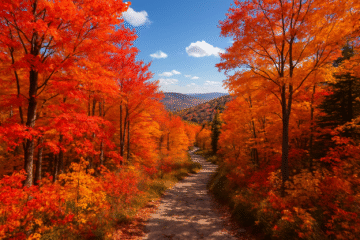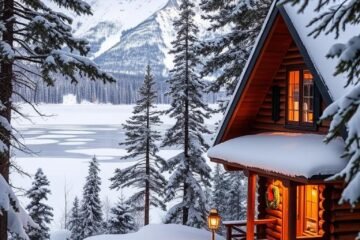The vast wilderness of the Last Frontier offers breathtaking landscapes and endless exploration. With over 57 million acres of untouched beauty, there’s no shortage of trails to discover. Whether near Anchorage, Denali, or the Kenai Peninsula, each path promises a unique adventure.
Late summer, especially August, is the perfect time to visit. The weather is mild, and the fall colors begin to paint the scenery. Trails in the Chugach Mountains, Kenai Fjords, and Denali National Park showcase stunning views and diverse wildlife.
Be prepared for sparse trail markings and possible wildlife encounters. Proper planning ensures a safe and rewarding experience. Whether you seek towering peaks or coastal vistas, there’s a trail waiting for you.
Table of Contents
Key Takeaways
- Late summer offers ideal hiking conditions.
- Popular regions include Denali and Kenai Fjords.
- Wildlife encounters require caution.
- Trails vary from marked paths to rugged routes.
- Proper preparation enhances safety and enjoyment.
Why Alaska’s Day Hikes Are Unmatched
Few places on Earth match the raw, untamed beauty found in Alaska’s backcountry. Its trails weave through landscapes untouched by heavy development, offering solitude and grandeur. With more wilderness than all other U.S. states combined, every step feels like a discovery.

Unlike the lower 48’s crowded networks, routes here blend rugged freedom with jaw-dropping geology. Imagine trekking past glaciers that crackle like thunder or coastal mountains draped in mist. The 15-mile lakeshore trail at Eklutna Lake even lets you rent bikes to cover more ground.
Wildlife sightings add thrill to every hike. Moose wade through marshes, while marmots whistle from rocky outcrops. In Denali, bears roam valleys carved by ancient ice. Pack binoculars—you’ll want a closer look.
| Feature | Alaska Trails | Lower 48 Trails |
|---|---|---|
| Wilderness Density | Highest in U.S. | Fragmented by roads |
| Daylight Hours (Summer) | Up to 24 hours | 12–16 hours |
| Glacial Views | Common | Rare outside Rockies |
Fairbanks’ Granite Tors Trail showcases another perk: midnight sun. Summer hikers relish extended golden hours to explore. Whether chasing history near old mines or summiting ridges, Alaska’s trails deliver unmatched variety.
Alaska’s Top Day Hikes for Outdoor Adventure Near Anchorage
Just outside Anchorage, hikers can explore trails that showcase glaciers, history, and breathtaking views. These routes range from moderate climbs to challenging ascents, all within a 30- to 120-minute drive. Pack bear spray and sturdy boots—you’ll need them.

Harding Icefield Trail: A Glacier Lover’s Dream
This 8-mile round-trip trail climbs 3,000 feet to panoramic views of the Harding Icefield. Summer hikers should expect slippery snow patches until late July. At Marmot Meadows, listen for whistles from playful marmots.
Bear sightings are common, so carry spray and make noise. The payoff? A jaw-dropping overlook of crevassed ice stretching to the horizon.
Crow Pass Trail: History and Scenic Splendor
Follow the historic Iditarod route on this 8-mile hike. Raven Glacier looms overhead, and wildflowers line the way. Be prepared for a knee-deep stream crossing—trekking poles help.
Extend your trip by backpacking to Eagle River Nature Center. The views of alpine valleys are worth the extra miles.
Pioneer Ridge Trail: Steep Climb, Stunning Payoff
This 9-mile round-trip trail gains 5,000 feet, rewarding effort with Knik Glacier vistas. Park at the designated lot (small fee applies) and watch for private land signs near the valley.
The final ridge section is rugged, but the 360-degree views make every step worthwhile.
Gear Tips for Anchorage-Area Hikes
Debating bear spray versus firearms? Spray is lighter and equally effective. Pair it with a bell to alert wildlife. Check trail conditions online—some routes hold snow well into summer.
Denali National Park’s Must-Do Day Hikes
From ridge scrambles to gentle loops, Denali’s trails cater to every adventurer’s skill level. The national park spans six million acres, with routes accessible via shuttle buses from the visitor center. Summer hikers enjoy long daylight hours and wildflower-dotted valleys.

Eielson Ridge Trail: Denali Up Close
This steep 1-mile trail climbs 1,000 feet from the Eielson Visitor Center. Shuttle buses along the 63-mile park road drop hikers here. Start early to spot Dall sheep on distant mountains.
Extend your hike by exploring the ridge’s unmarked paths. Clear days reveal Denali’s summit—only visible 30% of summer days due to cloud cover.
Savage River Loop: Family-Friendly Adventure
A free shuttle connects to this 4-mile trail, ideal for families. Skip the final 300-foot switchbacks for an easier route. Look for Arctic ground squirrels near the riverbanks.
For more solitude, venture into Toklat Valley’s cross-country zones. No marked trails exist, but tundra walking is straightforward.
| Feature | Eielson Ridge | Savage River |
|---|---|---|
| Distance | 1 mile (one way) | 4 miles (loop) |
| Shuttle Required | Yes (Park Road) | Yes (Free) |
| Best For | Summit views | Wildlife & families |
Pro tip: Buses allow on/off flexibility. Ask drivers about recent bear activity before choosing stops. Pack layers—weather shifts fast in the national park.
Kenai Peninsula’s Scenic Trails
Glacier-carved valleys meet ocean vistas along the Kenai Peninsula’s trails. This region blends accessibility with wild beauty, offering routes from family-friendly walks to challenging climbs. Coastal fog and alpine sunlight create ever-changing views.

Exit Glacier Overlook: Easy Access, Big Rewards
A 2-mile glacier trail winds to panoramic overlooks of the icy exit glacier. Marmot Meadows, the midpoint, bursts with wildflowers and whistling marmots. Continue to Top of the Cliffs for a bird’s-eye view of crevassed ice.
Ranger talks detail the glacier’s rapid recession—over 1,900 feet since 1950. Families love the ADA-accessible path, while hardcore hikers tackle the 8-mile Harding Icefield route nearby.
Portage Pass Trail: Short Hike, Big Payoff
This 4-mile round-trip trail climbs 1,600 feet to a 16-mile glacier vista. Post-avalanche repairs improved the route, but erosion persists—trekking poles help. Time your hike with Whittier’s rare sunny spells (annual rainfall: 198 inches).
Afterward, refuel at Seward’s best day hikes hub, Humpy’s Alehouse. Pair local brews with fresh-caught salmon.
- Pro tip: Combine Portage Pass with a Kenai Fjords boat tour for up-close glacier sightings.
- Gear up: Waterproof boots—stream crossings are common.
Hatcher Pass and Beyond: Hidden Gems
Tucked away in the rugged mountains, Hatcher Pass offers trails that blend adventure with untouched beauty. Less crowded than Denali or Kenai, this area rewards hikers with alpine vistas and echoes of gold-mining history.

Reed Lakes Trail: Alpine Lakes and Wildflowers
This 4-mile round-trip trail climbs 1,000 feet past waterfalls to twin alpine lakes. Snow lingers until July, so pack microspikes for early-season hikes. By mid-summer, the valley erupts with lupines and fireweed.
Photographers love the mirror-like reflections on Upper Reed Lake. Arrive at dawn for still waters and golden light. Watch for mountain goats on the surrounding ridges.
Independence Mine State Park: History Meets Hiking
Combine a 2-mile trail with exploration of abandoned gold mines. The 500-foot elevation gain is manageable, but snowdrifts persist into June. Stay on marked paths—collapsing tunnels dot the area.
Hardhats aren’t required but advised near ruins. Pair your hike with a tour of the visitor center to uncover Hatcher Pass’s boomtown past.
- Pro tip: From Palmer, take Fishhook-Willow Road for scenic access to both trails.
- Gear up: Trekking poles stabilize creek crossings and snowy patches.
Family-Friendly Hikes in Alaska
Gentle paths and interactive stops make hiking enjoyable for all ages. These routes blend safety with discovery, offering short distances and fascinating wildlife. From glacier walks to tide pools, kids will remember every mile.
Byron Glacier Trail: Toddler-Friendly Adventure
This 1-mile round-trip trail winds through avalanche chutes to a glacial valley. Flat terrain and interpretive signs keep young hikers engaged. Check closure updates—spring snowmelt can create hazards.
Pack extra snacks and layers. The glacier’s cool breeze surprises little ones, even in summer. Look for mountain goats on distant ridges.
Bishop’s Beach Walk: Tide Pools and Mountain Views
Low tide reveals starfish and hermit crabs along this 2-mile coastal trail. Time your hike using local tide charts—best explored 2 hours before low tide. The adjacent Wildlife Refuge Center offers Junior Ranger booklets.
Strollers roll easily on packed sand. Bring waterproof shoes for tidal streams. Afterward, spot sea otters from the beachfront picnic area.
| Feature | Byron Glacier | Bishop’s Beach |
|---|---|---|
| Distance | 1 mile (RT) | 2 miles (RT) |
| Best For | Ages 3+ | Ages 5+ |
| Unique Highlight | Glacial valley | Tide pool ecosystems |
- Bear safety: Teach kids to clap and sing on wooded trails.
- Snack strategy: Pre-pack individual portions to minimize stops.
- Gear tip: Use child-sized binoculars for wildlife spotting.
Essential Gear for Alaska’s Trails
Packing the right gear makes all the difference when exploring rugged trails. Weather shifts quickly, and trail difficulty varies from rocky slopes to river crossings. Smart choices keep you safe and comfortable during your trip.
Bear Safety: Spray vs. Firearms
Exit Glacier surveys show 89% of hikers carry bear spray, while only 11% opt for firearms. Spray is lighter, non-lethal, and effective up to 30 feet. Always keep it accessible—not buried in your pack.
| Feature | Bear Spray | Firearm |
|---|---|---|
| Weight | 8–12 oz | 2+ lbs |
| Range | 30 ft | Varies |
| Success Rate | 92% | 76% |
Waterproof Gear for Coastal Trails
Whittier-area trails average 198 inches of rain yearly. Waterproof boots with ankle support prevent slips on wet rocks. Pair them with a breathable rain jacket—sealed seams are key.
- Layering System:
- Base: Moisture-wicking merino wool
- Mid: Insulating fleece or down
- Outer: Windproof shell
- Footwear: Choose drainage (river crossings) or ankle support (rocky terrain).
Navigation and Emergencies
GPS devices work well but carry a map/compass as backup. Cell service is spotty in remote areas. For emergencies, pack a space blanket—lighter than a bivvy but still reflective.
Food storage follows state rules: Use bear-proof containers or hang bags 10 feet high. Never leave snacks in your tent—curious wildlife hiking nearby won’t hesitate to investigate.
Wildlife Safety Tips for Hikers
Wildlife encounters can turn thrilling—or dangerous—without proper precautions. From bears to moose, knowing how to react protects both hikers and animals. Follow these guidelines to ensure your adventure stays safe.
Bear Safety Essentials
Carry bear spray within reach—not buried in your pack. Aim for a 30-foot range, and practice removing the safety clip beforehand. In Eagle River, moose attacks outnumber bear incidents 3:1, but both demand caution.
| Tool | Effectiveness | Best For |
|---|---|---|
| Bear Spray | 92% deterrent rate | Close encounters |
| Noise Maker (Bell) | Moderate | Forested routes |
| Human Voice | High | Open areas |
Moose and Other Wildlife
*Moose aggression peaks in spring* during calving season. Give them 50+ feet of space—they charge faster than bears. If one approaches, hide behind a tree or retreat slowly.
- Food storage: Use bear-proof containers or hang bags 10 feet high. Never cook near your tent.
- Group size: Hike with 4+ people in high-risk zones—bears avoid larger groups.
- Emergency devices: Satellite messengers (InReach vs. SPOT) outperform cell phones in remote parks.
Pack Creek’s float-plane drop-offs require advance permits. Check park websites for seasonal closures and updates. Stay alert, and your hike will be unforgettable for all the right reasons.
Best Time of Year to Hike in Alaska
Timing is everything when planning a hiking adventure in the Last Frontier. The state’s dramatic seasons dictate trail conditions, wildlife activity, and even crowd levels. Aim for late June to early September for the safest and most scenic time.
July brings peak mosquitoes but also lush greenery. By August, bugs fade, and fall colors ignite in Hatcher Pass. For solitude, avoid cruise ship crowds by hiking midweek or early mornings.
Seasonal Trail Tips
- Summer (June–August): Warm temps and 18+ hours of daylight. Pack bug spray—July is peak mosquito time.
- Fall (September): Crisp air and golden tundra. Trails remain open until snow hits.
- Winter: Snowshoes or microspikes required. Daylight dwindles to 5 hours.
Shoulder seasons (May and late September) offer quiet trails but unpredictable weather. Sudden storms or thawing permafrost can make routes slippery. Check state park updates before your trip.
At the end of the day, late summer balances comfort and beauty. Whether chasing wildflowers or autumn hues, plan around nature’s clock for an unforgettable hike.
Planning Your Alaska Hiking Trip
Smart planning transforms a good hike into an unforgettable journey. From permits to shuttle buses, details ensure a seamless trip. Start early—popular spots like Denali National Park fill up fast.
Permits and Logistics
Chugach State Park requires camping permits for backcountry stays. Fees vary by site, with Eagle River Nature Center charging $5 for parking. Reserve shuttle buses 60+ days ahead for Denali National Park routes.
| Option | Cost Range | Best For |
|---|---|---|
| Guided Tours | $150–$400/day | First-time visitors |
| Self-Guided | $0–$50 (permits) | Experienced hikers |
Lodging Choices
RV camping suits flexible itineraries, while hotels near park entrances offer comfort. Compare costs—Anchorage hostels start at $30/night, but remote lodges hit $200+.
- Trail updates: AllTrails shows recent conditions, but ranger stations provide real-time hazards like rock slides.
- Bear cans: Required in some zones; rent them for $10/week at visitor centers.
Pack for all weather—the way to enjoy Alaska’s trails is by expecting the unexpected. Check sunset times for safe returns.
Conclusion
Exploring these trails offers more than just exercise—it’s a journey through nature’s finest masterpieces. From Harding Icefield’s glaciers to Hatcher Pass’s alpine lakes, each route delivers unique adventure.
Remember key safety tips: carry bear spray, store food properly, and respect wildlife distances. For deeper insights, grab the guidebook 55 Ways to the Wilderness—it’s a goldmine for Alaska hiking routes.
Pack smart: layers for shifting weather, waterproof boots, and a seasonal checklist. Summer demands bug spray, while fall calls for extra warmth. Follow backpacking tips to minimize your impact and leave trails pristine.
Whether it’s your first visit or fiftieth, the right prep ensures every time on the trail is unforgettable. Lace up, step out, and let the wilderness inspire you.



0 Comments